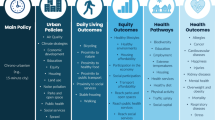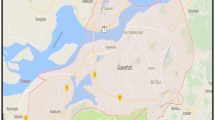Abstract
“Healthcare for all” is integral to achieve social equity. The geographical network of point of health care (POHC) is often limited by connectivity, accessibility and equity issues in developing areas. Matured spatial analysis techniques make ease in the identification of gaps and help to improve the healthcare system. This study sought to analyze inadequacy and equity issues in physical accessibility of POHC system in a developing area, Muzaffargarh, Pakistan by data variables representing the aggregated population, road network, travel time and transportation mode using network analyst in ArcGIS. Potential service catchment areas are delineated for a geographic network of existing POHCs’ at 5, 10, and 15 min of travel time. Further Agent-Based Model (ABM), a python script-based program in the ArcGIS environment, as the computational method is used for the location-allocation of new POHC to suggest improvements in the efficacy of the existing healthcare system. The proposed ABM approach has improved the overall efficacy of the system by identifying 13 new sites for POHC. Urban areas (zone 3, 5) are observed to have large service catchment and high accessibility for the community due to an efficient road network. However, rural areas (zone 1, 2, and 4) are identified as weak accessibility regions due to the poor road network and inadequate distribution of existing POHCs.








Similar content being viewed by others
References
Afshari, A., Mojahed, M., & Yusuff, R. M. (2010). Simple additive weighting approach to personnel selection problem. International Journal of Innovation, Management and Technology,1(5), 511.
Afzal, U., & Yusuf, A. (2013). The state of health in Pakistan: An overview.
Black, M., Ebener, S., Aguilar, P. N., Vidaurre, M., & El Morjani, Z. (2004). Using GIS to measure physical accessibility to health care. In ESRI 2004 international health conference proceedings. World Health Organization, 3–4.
Campbell, S. M., Roland, M. O., & Buetow, S. A. (2000). Defining quality of care. Social Science and Medicine,51(11), 1611–1625.
Gatrell, A. C., & Elliott, S. J. (2014). Geographies of health: An introduction. Hoboken: Wiley.
Hare, T. S., & Barcus, H. R. (2007). Geographical accessibility and Kentucky’s heart-related hospital services. Applied Geography, 27(3–4), 181–205.
Imran, H. A., Schröder, D., & Munir, B. A. (2017). Agent-based simulation for biogas power plant potential in Schwarzwald-Baar-Kreis, Germany: A step towards better economy. Geocarto International,32(1), 59–70.
Jones, A. P., Bentham, G., Harrison, B. D. W., Jarvis, D., Badminton, R. M., & Wareham, N. J. (1998). Accessibility and health service utilization for asthma in Norfolk, England. Journal of Public Health, 20(3), 312–317.
Joseph, A. E., & Phillips, D. R. (1984). Accessibility and utilization: Geographical perspectives on health care delivery. Thousand Oaks: Sage.
Kalogirou, S., & Foley, R. (2006). Health, Place and Hanly: Modelling accessibility to hospitals in Ireland. Irish Geography,39(1), 52–68.
Khalesian, M., & Delavar, M. (2008). A multi-agent based traffic network micro-simulation using spatio-temporal GIS (Vol. 10, pp. 31–36). Center of Excellence in Geomatics Engineering and Disaster Management.
Khaliq F. A. W. (2018). State of Health Sector in Pakistan. Retrieved from Pakistan: http://www.sbp.org.pk/publications/staff-notes/State-of-Health-Sector-in-Pakistan-(06-04-2018).pdf. Accessed 15 Sept 2018.
Kim, Y., Byon, Y.-J., & Yeo, H. (2018). Enhancing healthcare accessibility measurements using GIS: A case study in Seoul, Korea. PLoS ONE,13(2), e0193013.
Laboratory, O. R. N. (2013). High Resolution global Population Data Set copyrighted by UT-Battelle. Retrieved from: https://landscan.ornl.gov/landscan-datasets. Accessed 15 Sept 2018.
Luo, W., & Wang, F. (2003). Measures of spatial accessibility to health care in a GIS environment: Synthesis and a case study in the Chicago region. Environment and Planning B: Planning and Design,30(6), 865–884.
Memariani, A., Amini, A., & Alinezhad, A. (2009). Sensitivity analysis of simple additive weighting method (SAW): The results of change in the weight of one attribute on the final ranking of alternatives. Journal of Optimization in Industrial Engineering,2(4), 13–18.
Mendas, A., Errih, M., Daho, S. B., Hamadouche, M. A., & Saidi, A. (2010). Water impoundment location. Approach using GIS and multicriteria decision making. Revue Internationale de Géomatique,20(1), 87–103.
Millman, M. (1993). Access to health care in America. Washington, DC: National Academies Press.
Murad, A. A. (2004). Creating a GIS application for local health care planning in Saudi Arabia. International Journal of Environmental Health Research,14(3), 185–199.
North, M. J., Collier, N. T., & Vos, J. R. (2006). Experiences creating three implementations of the repast agent modeling toolkit. ACM Transactions on Modeling and Computer Simulation (TOMACS),16(1), 1–25.
Obrist, B., Iteba, N., Lengeler, C., Makemba, A., Mshana, C., Nathan, R., et al. (2007). Access to health care in contexts of livelihood insecurity: A framework for analysis and action. PLoS Medicine,4(10), e308.
Ohta, K., Kobashi, G., Takano, S., Kagaya, S., Yamada, H., Minakami, H., et al. (2007). Analysis of the geographical accessibility of neurosurgical emergency hospitals in Sapporo city using GIS and AHP. International Journal of Geographical Information Science,21(6), 687–698.
Okafor, F. C. (1990). The spatial dimensions of accessibility to general hospitals in rural Nigeria. Socio-Economic Planning Sciences,24(4), 295–306.
Penchansky, R., & Thomas, J. W. (1981). The concept of access: Definition and relationship to consumer satisfaction. Medical Care,19, 127–140.
Rosero-Bixby, L. (2004). Spatial access to health care in Costa Rica and its equity: A GIS-based study. Social Science and Medicine,58(7), 1271–1284.
Statistics, P. B. O. (2017). Statistical pocket book of the Punjab. Lahore: Bureau of Statistics.
Statistics, P. B. O. S. (2018). National Health Accounts Pakistan 2015-16. Retrieved from Pakistan: http://www.pbs.gov.pk/sites/default/files//NHA-Pakistan%202015-16%20Report_0.pdf. Accessed 15 Sept 2018.
Tsoka, J., & Le Sueur, D. (2004). Using GIS to measure geographical accessibility to primary health care in rural South Africa: Research in action. South African Journal of Science,100(7–8), 329–330.
WH Organization. (1998). District health facilities: Guidelines for development and operations. Manila: WHO Regional Office for the Western Pacific.
Wu, J., Wang, J., & Strager, M. P. (2011). A two-stage GIS-based suitability model for siting biomass-to-biofuel plants and its application in West Virginia, USA. International Journal of Forest Engineering,22(2), 28–38.
Acknowledgements
The authors would like to acknowledge RNL’s LandScan™ for providing population data, Irrigation Department Pakistan for providing mapping units (settlement data), and Alhasan Systems Private Limited for providing road network.
Author information
Authors and Affiliations
Contributions
Conceptualization: BAM, RI, SH; Analysis: BAM, RI, SH; Writing-Original Draft Preparation: BAM, SH, SR, MAJ; Writing-Review & Editing: SH, BAM, SR, MAJ, RI.
Corresponding author
Ethics declarations
Conflict of interest
The authors declare no conflict of interest.
Human and animal rights
This article does not contain any studies with human or animal subjects performed by the any of the authors.
Additional information
Publisher's Note
Springer Nature remains neutral with regard to jurisdictional claims in published maps and institutional affiliations.
Rights and permissions
About this article
Cite this article
Munir, B.A., Hafeez, S., Rashid, S. et al. Geospatial assessment of physical accessibility of healthcare and agent-based modeling for system efficacy. GeoJournal 85, 665–680 (2020). https://doi.org/10.1007/s10708-019-09987-z
Published:
Issue Date:
DOI: https://doi.org/10.1007/s10708-019-09987-z




